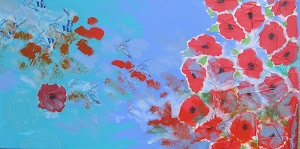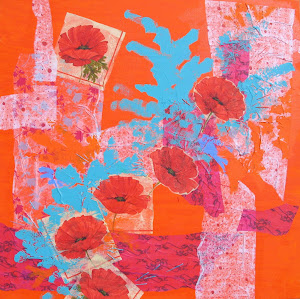

I was thrilled with how well this unit worked for all grade levels!!! Unique artwork, many different challenges and skills, lots of concepts and bright colors!






First, students were given an assortment of objects from nature to observe and draw using Sharpie. K-2nd grade were given shells only, while 3rd-5th grade were given shells, cacti, succulents, aloe and airplane plants, gourds and artificial (but realistic) flowers, plus a rather large cactus pinata! With each grade level, we discussed observation drawing and described that drawing process in the following ways:
Observation drawing is...
- Drawing what you see (not what you remember or imagine.)
- Drawing from life.
- Drawing something that's in front of you, and constantly looking at the object as you draw it.
- Drawing all parts of the object - shape, form, details, texture, etc.



Observation drawing is...
- Drawing what you see (not what you remember or imagine.)
- Drawing from life.
- Drawing something that's in front of you, and constantly looking at the object as you draw it.
- Drawing all parts of the object - shape, form, details, texture, etc.



Students drew with Sharpie so that they would have to challenge themselves to turn their mistakes into part of their composition. Nature is a particularly good subject for this assignment because of all the imperfections and variations found in nature.
Everyone was given a 12"x12" sheet of white sulphite construction paper. Though we were drawing the objects as realistically as possible, the composition did not have to be realistic. I gave the students the following drawing challenges and asked that they tried to do all three as part of their composition:
- Draw at least 1-2 objects larger than life
- Draw at least 1 object cropped (going off the page)
- Draw at least 1 object repeated*
*For the repetition challenge, students were instructed that they could not simply copy one of their drawings. To repeat the object, it had to be drawn from observation again.
To sum it up, the drawing portion of this assignment included drawing from observation, drawing without the ability to erase, cropping, repetition and enlargement. I keep a checklist of all the drawing challenges on the board for the students to check their work as they get close to being finished. We discuss how each challenge helps to exercise different important drawing skills, as well as contributing to an interesting composition.
Everyone was given a 12"x12" sheet of white sulphite construction paper. Though we were drawing the objects as realistically as possible, the composition did not have to be realistic. I gave the students the following drawing challenges and asked that they tried to do all three as part of their composition:
- Draw at least 1-2 objects larger than life
- Draw at least 1 object cropped (going off the page)
- Draw at least 1 object repeated*
*For the repetition challenge, students were instructed that they could not simply copy one of their drawings. To repeat the object, it had to be drawn from observation again.
To sum it up, the drawing portion of this assignment included drawing from observation, drawing without the ability to erase, cropping, repetition and enlargement. I keep a checklist of all the drawing challenges on the board for the students to check their work as they get close to being finished. We discuss how each challenge helps to exercise different important drawing skills, as well as contributing to an interesting composition.






Once the Sharpie drawings were complete, we were ready to add color! To make the drawings more interesting, and to tie in another important concept, I had different grade levels work with different color schemes that were appropriate for their grade. The examples in this whole post are from 3rd-5th grade, who used the complementary color groups:
-purple and yellow
-red and green
-blue and orange
Students chose a complementary color pair, and then used variations of one of those colors to add details and texture with oil pastels. For example, if a student chose blue and orange, then they would be able to use all of the shades of blue OR all the shades of orange to color with using oil pastels. When using oil pastels, students were encouraged to shade some areas solid, to shade lightly in some areas, to add patterns, details and textures to some areas, and to add a design to the background area. They had to leave some areas white, though in order for the watercolor to have a place to stick!



Then, once details with oil pastels were complete, students painted over their drawings with watercolor tempera paint using the complement of the color they used for oil pastels. So, for example, if the student chose orange for oil pastels, then they would be painting with variations of blue. I taught the students how to make variations of their color by mixing in small amounts of the colors adjacent to their main color on the color wheel. For example, if a student was painting with blue, then they could mix in small amounts of purple, green or white to create new shades of blue. This was such a fun mixing lesson! The process is called a resist - the oil in the pastels resists the watercolor and does not allow it to stick to the paper in those spots. Science and art working together!




Again, these examples are from grades 3-5. I will do a separate post about grades 1-2, and kindergarten, who worked with different color schemes.




Can't wait to show off more of this incredible unit!




























































11 comments:
These are amazing! I love how you gave them "drawing challenges" to try to incorporate into their work. I am so borrowing this! Yay Mrs. Gonzalez! :)
I absolutely love this! I like the fact that you are doing observational drawing, setting ground rules, and then combining in some color theory. The limited colors make these very striking to look at. Wow!
Very very nice!!! Congratulations!
I love your student's art works! I have added you to my art teacher blog role, would love for you to add my blog to your list too!
Oh WOW! These are so fantastic! What a great lesson to incorporate so many art principles: observational drawing, compositional skills, color theory... These pieces are so striking. I am definitely going to try this out. Thanks for such a great lesson idea!
I really enjoy your blog! I've passed along a Stylish Blogger Award. Thanks for all your inspiring ideas.
Absolutely GREAT! The colors, the drawings...
FELICIDADES!!!!!
This post came just at the right time! I did a variation of your lesson with my second graders and blogged about it.
http://artabroad.blogspot.com/2011/04/school-supply-drawings.html
Thanks for all the great ideas!
Stephanie - I checked out your post - they look awesome! Thanks for sharing, glad you like the unit!
Beautiful art work! Thanks for the complete directions. I am curious about 'watercolor tempera paint'. Do you mean tempera cakes?
I have added you to the blogroll on my new blog www.k6art.com
Hi Rina, thanks for the compliment! Yes, I was referring to tempera cakes ;) The way we use them, I always think of them as being more like watercolors!
Post a Comment